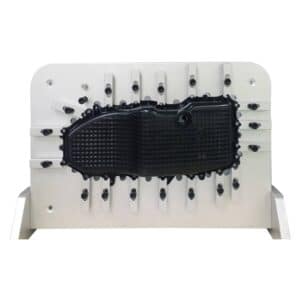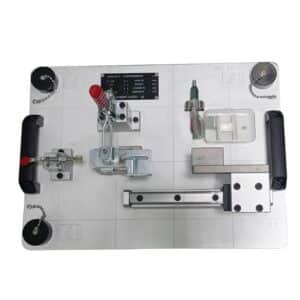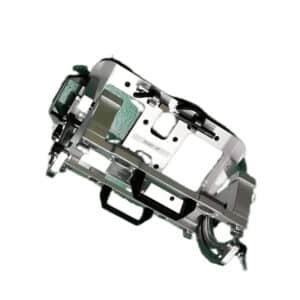Phone:
+86 13828 600940
Physical address:
No.8Liyuan Road, Bogang community, Shajing Street Baoan District, Shenzhen, China

Auto checking fixtures play a pivotal role in manufacturing industries by assuring accuracy and quality during product production. Although these fixtures were traditionally built manually, their current designs are increasingly complex due to customization requests and rising costs. As technology rapidly develops, innovative solutions are emerging to revolutionize auto checking fixtures’ future. This article highlights the challenges associated with traditional fixtures, highlights the exciting advances in technologies and materials, discusses artificial intelligence and automation integration, 3D printing accuracy enhancement and future predictions that may influence this industry. By adopting such innovative technologies and advancements manufacturers can optimize production processes while simultaneously assuring superior product quality.

Understanding the Role of Auto Checking Fixtures in Manufacturing
Auto checking fixtures are unsung heroes of manufacturing. They play an invaluable role in assuring quality and accuracy during the production process, and serve as tools or devices which hold and position components or parts correctly, enabling manufacturers to inspect everything is aligned correctly, within tolerance, and meets required specifications.
Imagine auto checking fixtures as the inspectors of manufacturing. They assist manufacturers in identifying and rectifying any defects prior to final product release, preventing costly mistakes, rework or product recalls from happening – in other words ensuring the end product meets high quality standards.
Traditional Fixture Inspection Methods Are Time Consuming and Complex
Customization and Adaptability Are Limited
Considerations Regarding Cost and Maintenance Considerations
Traditional checking fixtures have long been an asset to manufacturing industry, yet they do present challenges and limitations. One such difficulty lies in their complexity and time-intensive production process – slowing production down while increasing costs.
Additionally, traditional checking fixtures often lack customization and adaptability; they’re usually tailored for specific parts or components, making it hard to use them with various products or manufacturing processes. This lack of flexibility may prevent innovation while increasing overall production times.
Cost and maintenance should also be carefully considered when making decisions about fixtures. Traditional fixtures can be costly to build and maintain, contributing significantly to production costs overall. Furthermore, any modifications or updates require significant resources from both time and resources perspectives.

Advances in Sensor Technology for Automatic Fixture Checking
Integration of IoT for Real-Time Data Monitoring
Intelligent Algorithms to Aid Decision-Making
Future auto checking fixtures rely on emerging technologies and innovative solutions, including sensor advancement. Integrating high-precision sensors into auto checking fixtures enables manufacturers to gather real-time information about product dimensions, tolerances and other key parameters – leading to more precise quality control with reduced manual inspection needs.
Internet of Things (IoT) integration into auto checking fixtures is another exciting breakthrough. By connecting these fixtures to networks, manufacturers can track and analyze data remotely in real-time for real-time monitoring and decision-making thereby minimizing downtime and increasing productivity.
Smart algorithms can further enhance auto checking fixture capabilities. These algorithms are able to analyze data patterns, identify trends, and make informed decisions based on predefined rules – automating certain decision-making processes can allow manufacturers to enhance both efficiency and accuracy in quality control processes.
High Performance Composite Materials (HPCMs)
Metamaterials and Their Influence on Fixture Design
Materials Which Are Heat Resistant and Lightweight
Material science innovations are also making a contribution to auto checking fixtures’ future success. High-performance composite materials offer numerous advantages for auto checking fixtures’ design and production processes, such as better strength-to-weight ratio, corrosion resistance and reduced maintenance requirements – ultimately producing lighter fixtures while optimizing both performance and cost-effectiveness.
Metamaterials, an engineered material with unique properties not found in nature, are having an increasing influence on fixture design. With negative refractive index properties allowing fixtures with unconventional shapes and designs to be created. This provides new opportunities for more efficient inspection processes.
Heat-resistant and lightweight materials are revolutionizing auto checking fixtures’ capabilities. These materials can withstand high temperatures while still offering excellent thermal stability – making them suitable for industries operating under difficult operating conditions. Plus, their lightweight nature reduces energy usage for faster manufacturing processes.
As time progresses, these innovative technologies and advances in material science will shape the next generation of auto checking fixtures. Manufacturers can anticipate enhanced accuracy, efficiency and adaptability in their quality control processes resulting in higher-quality products and increased customer satisfaction.
Integrating Artificial Intelligence and Automation
Gone are the days of manual trial-and-error when it comes to optimizing auto checking fixtures. With artificial intelligence (AI) and machine learning algorithms in the mix, optimizing fixtures has never been more intelligent or efficient. AI/ML algorithms can analyze large datasets to find patterns to improve design and performance of checking fixtures – it’s like having your own virtual engineer who learns with each iteration for maximum results!
Automated Inspection and Defect Detection Solutions Provide a quick solution for inspection of machinery components.
Get rid of human error and embrace automated inspection and defect detection systems powered by AI-powered systems. They can now quickly analyze real-time data from checking fixtures to quickly identify any defects or deviations from specifications, which not only ensures higher accuracy and precision but also saves valuable time in the inspection process. Imagine having a robot working tirelessly on behalf of your products that meet all quality standards!
AI-enabled Predictive Maintenance Solutions
No one enjoys unexpected breakdowns when it comes to checking fixtures. AI-enabled predictive maintenance takes the guesswork out of maintenance schedules by using real-time data to predict when fixtures may fail, helping prevent costly downtime while prolonging lifespan and prolonging service. Preventative maintenance acts as a kind of crystal ball telling when maintenance should take place before problems arise.
Additive Manufacturing Techniques for Customized Fixtures
Gone are the days of standardized checking fixtures: now manufacturers can create personalized pieces made just for them with 3D printing technology. Additive manufacturing techniques allow intricate designs and complex geometries that would have previously been impossible using traditional manufacturing techniques – meaning increased accuracy and precision during inspection processes while decreasing error margins.

Application of Multi-Material 3D Printing
3D printing offers manufacturers many opportunities for customizing fixtures with multiple materials, providing greater material versatility. Manufacturers can then optimize performance according to specific inspection requirements; using rigid and flexible materials simultaneously could increase stability while accommodating variations in parts being inspected.
Benefits and Limitations of 3D Printed Checking Fixtures
Though 3D printing offers many advantages, such as cost-efficiency and design flexibility, it does have some drawbacks. Size and weight restrictions of printers can limit production of large or heavy fixtures; furthermore, material properties of printed parts may differ significantly from traditionally manufactured fixtures; but continuous advances in 3D printing technology are making 3D printing an increasingly viable choice for auto checking fixtures.
Implementation of Augmented Reality for Checking Fixture Assembly
Imagine donning a pair of augmented reality glasses and receiving step-by-step instructions for assembling a checking fixture with ease and accuracy, using virtual guidance with real-time feedback to streamline assembly processes and minimize errors, thus shortening assembly times significantly. Now this future-forward trend is becoming reality! Augmented reality technology is being integrated into fixture assembly processes to maximize efficiency and accuracy while decreasing assembly times significantly.
Robotics Are Ideal for Automated Fixture Adjustment
Robots have come a long way since their original use on production lines; now they are entering the field of checking fixture adjustment. Equipped with sensors and AI capabilities, robotic systems can autonomously adjust fixtures based on real-time measurements to save both time and ensure consistent and accurate adjustments reducing manual intervention costs.
Wireless Communication and Cloud-Based Data Management Solutions
As our world becomes ever more connected, auto checking fixtures have taken to adopting wireless communication and cloud-based data management technologies. By embedding sensors in fixtures, real-time data collection and transmission can take place wirelessly for instant monitoring and analysis, which can then be stored and accessed via cloud platforms for remote collaboration, real-time analytics and improved decision making.
Auto checking fixtures have an exciting future ahead of them. Thanks to AI and automation, the optimization, inspection, and maintenance processes are becoming more intelligent and efficient; 3D printing has revolutionized customization and material capabilities of fixtures while increasing accuracy and precision. Augmented reality, robotics, and wireless communication trends will soon disrupt this industry even further, increasing productivity and quality levels further still. Manufacturers would do well to embrace these advancements to stay at the top of their game!
1 What are auto checking fixtures, and why are they essential to manufacturing?
Auto checking fixtures are used in manufacturing to ensure accuracy and quality during product production. They help verify dimensions, alignments and other key parameters so products meet specifications required by their specifications. Auto checking fixtures play a crucial role in maintaining consistency, reducing defects, and improving overall product quality.
2. How have cutting-edge technologies, such as artificial intelligence and automation, altered auto checking fixtures?
Emerging technologies, such as artificial intelligence (AI) and automation, can have an immense impact on auto checking fixtures. AI algorithms can optimize fixture designs, automate inspection and defect detection processes, facilitate predictive maintenance practices and simplify checking procedures to reduce human error while increasing efficiency – ultimately improving speed, accuracy and reliability in auto checking fixtures.
3. What role will 3D printing play in the future of auto checking fixtures?
3D printing offers several advantages for auto checking fixtures. It enables manufacturers to rapidly produce customized fixtures tailored specifically to different products and production requirements, while multi-material 3D printing enables complex fixture designs incorporating various materials with differing properties to be realized. Furthermore, 3D printing increases accuracy and precision resulting in more reliable and efficient checking processes.
4. What are some future trends and predictions regarding auto checking fixtures?
Auto checking fixtures hold many exciting possibilities for the future. Trends and predictions include the integration of augmented reality in fixture assembly, using robotics for automated fixture adjustment and wireless communications for cloud-based data management – these developments aim to streamline and optimize the checking process in order to increase productivity while decreasing costs while expanding manufacturing capabilities.